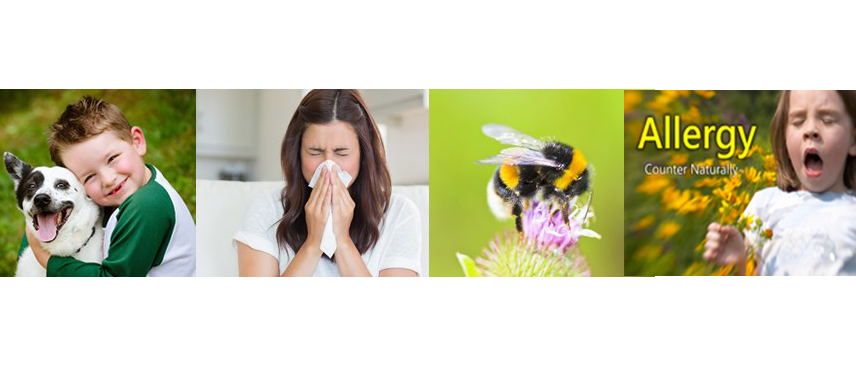
Environmental Allergy
Introduction

Runny noses, itchy watery eyes, and sneezing bother many Americans with environmental allergies, especially during pollen season. While outdoor allergies from grass, weeds, and trees may be seasonal, indoor allergies from dust mites and pet dander can cause problems all year round. There are many ways you can reduce your exposure to allergens (things that cause allergies). Immunotherapy shots are a way to desensitize the body and can provide permanent freedom from allergies for many people.
Anatomy
Your immune system usually fights germs to keep you healthy. If you have allergies, your immune system overreacts to ordinary substances that normally are not harmful. The substances that trigger an allergic reaction are called allergens.
When you are exposed to an allergen, your white blood cells produce antibodies. The antibodies trigger the release of histamine and other chemicals in your blood called mediators. The mediators cause the symptoms of the allergic reaction.
Causes
There are many causes of environmental allergies. Outdoor seasonal allergies originate from plant pollens during the growing season. Year-round indoor allergies are present at any time of the year.
Outdoor seasonal allergens include pollen from:
• Trees
• Grass
• Weeds
Year-round indoor allergens include:
• Dust mites
• Mold
• Cockroaches
• Pet Dander
Symptoms

The symptoms of environmental allergies vary from person to person. Common allergy symptoms include a runny nose, sneezing, itchy watery eyes, and bags under the eyes.
Diagnosis
An allergist can diagnose environmental allergies by reviewing your medical history and conducting a physical exam. A blood test or skin test is used to identify specific allergens. For the skin test, your allergist will inject a small amount of allergen into your skin. After a short time, a red bump will appear if you are allergic to the substance.
Treatment
You should adjust your lifestyle to avoid environmental allergens as best you can. Your doctor may recommend over-the-counter or prescription medications, including antihistamines, corticosteroids, and decongestants. There are many different types of allergy medications, and you may have to try a few different ones before you find the best ones for you.
Immunotherapy may be recommended for people with severe environmental allergies or after medication treatments have failed to treat symptoms. Immunotherapy involves receiving a series of injections of small amounts of allergens to desensitize the body’s response to the allergens. Over a period of about three to five years, immunotherapy injections can eliminate or reduce environmental allergic reactions for many people.
Your allergist may prescribe an emergency shot of epinephrine (EpiPen, EpiPen Jr., Twinject) for you to carry with you at all times if you have severe allergic reactions. You should instruct those around you how to give you the emergency shot if you are unable to do so. You should receive emergency medical treatment even if you used the shot.
Prevention
You can help prevent allergies by avoiding the allergens that you can. Here are some tips:
• Take a shower after spending time outdoors.
• Wash pets once a week.
• Wash bed linens in the hottest water possible. Do not dry laundry outside. Use special allergy covers on pillows and mattresses.
• Keep windows shut and use an allergen filter in your central air conditioner and heating system. Keep the humidity in your house as low as possible.
• Vacuum rugs and keep floors clean.
Helpful tips to do around my house
Dust Mites
Dust mites are one of the most common causes of year round allergies and asthma. Dust mites are microscopic organisms that feed on live and dead skin tissue. Mites are commonly found in pillows, mattresses, stuffed animals, carpets, upholstered furniture and some clothing. The average life span of one dust mite is between 20-30 days, although some can live up to 80 days. Limit your exposure to dust mites by:
• Enclosing mattresses, box springs and pillows with dust mite covers
• Wash bedding and pillows 2-3 times weekly in hot water (130º F)
• Vacuum carpet 1-2 times per week – make sure the vacuum cleaner has a HEPA filter
• Avoid humidifiers. Anything below 50% humidity will help keep dust mite count low. Keep Air Conditioning on during summer months
• Minimize stuffed toys and wash them at least monthly or place them in a plastic bag and freeze them overnight to kill the dust mites.
Molds
Molds are tiny fungi whose spores float through the air and can be found everywhere including soil, plants and rotting wood. Molds like damp environments and need four things to grow: food, air, warm temperature and water. They can be found both in your home and outdoors. An allergy to mold can be very dangerous and can trigger asthma symptoms such as wheezing, shortness of breath or chest tightness. Help your mold allergy symptoms by:
• Eliminating mold from your home by fixing leaky faucets & pipes
• Reduce the humidity in your home. Use a dehumidifier is necessary
• Stay away from uncut fields and avoid raking leaves
• Disinfect bathroom, basement walls and furniture with diluted bleach, vinegar or other disinfectant solutions
• Remove moldy or mildewed articles such as books, fabrics, rugs, stuffed animals or wallpaper
• Keep windows closed at night and if possible, use air conditioning which cleans, cools and dries the air
• If mold covers an area of more than 10 square feet, consider hiring an environmental specialist
Pollen
Pollen is a very fine powder that comes from trees, grasses, weeds, and flowers. Birds and wind carry this pollen from plant to plant in order to fertilize them. When people who have a pollen allergy inhale the pollen, they experience allergy symptoms such as sneezing, stuffy nose, itchy eyes, coughing and much more. Weeds usually pollinate in the late summer and fall with ragweed being the biggest culprit for causing hay fever symptoms. Trees typically pollinate late winter and early spring. Grasses pollinate in the spring and early summer. To find out if you’re are being affected by the pollen count in your area today, please use our pollen count check shown on your left. Help limit your contact with pollen by:
• Limiting your time outdoors when pollen counts are high
• Wearing a mask when cutting grass or raking leaves (after exposure, rinse eyes with artificial tears, rinse the nose with saline irrigations, rinse the mouth with fresh water and take a shower. Throw your outdoor clothes in the washer as soon as you come in the house)
• Cleaning and replacing air conditioner filters often
• Sleeping with your windows closed
• Increasing dietary intake of Vitamin C – this helps boost your immune system
Am I at Risk
The following are risk factors for environmental allergies:
• Allergies can run in families. If other members of your family have allergies, you have a risk of developing allergies.
• If you have one type of allergy, you are more likely to have another type of allergy.
• If you have asthma, you have an increased risk for allergies
• Children are more likely to develop allergies, although allergies can occur at any age.
Complications
Environmental allergies can contribute to other medical conditions including asthma, rashes, sinus infections, ear infections, and lung infections.
References:
http://www.everydayhealth.com/allergy-pictures/top-6-environmental-allergies.aspx#/slide-1
http://www.webmd.com/allergies/tc/environmental-illness-overview
http://www.uptodate.com/contents/allergic-rhinitis-seasonal-allergies-beyond-the-basics







